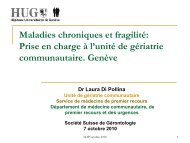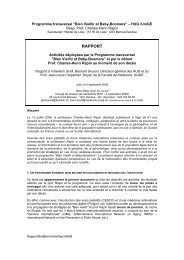Palliative care for older people - World Health Organization ...
Palliative care for older people - World Health Organization ...
Palliative care for older people - World Health Organization ...
Create successful ePaper yourself
Turn your PDF publications into a flip-book with our unique Google optimized e-Paper software.
By 2050, estimates indicate that more than onequarter of the population of the European Regionwill be aged 65 years and <strong>older</strong>. In Spain and Italy,this is likely to rise to more than one third of thepopulation. The greatest percentage increase will beamong <strong>people</strong> aged 85 years and <strong>older</strong>. Althoughdisability is declining among populations of <strong>older</strong><strong>people</strong> in high-income countries, the increase inabsolute numbers means that increasing numbersof <strong>older</strong> <strong>people</strong> in almost every society will face therisk of indifferent or poor health <strong>care</strong>, dependenceand multiple illnesses and disabilities. This will alsoinevitably lead to higher demand <strong>for</strong> palliative <strong>care</strong><strong>for</strong> this group.Changing disease patterns<strong>Palliative</strong> <strong>care</strong> has traditionally been offered to<strong>people</strong> with cancer, but <strong>people</strong> aged 85 years and<strong>older</strong> are more likely to die from cardiovasculardisease than cancer (Fig. 1.2). Better meetingthe needs of <strong>older</strong> <strong>people</strong> in the future requiresimproving and widening the access to palliative <strong>care</strong>to include <strong>people</strong> dying from diseases other thancancer and who have multiple illnesses.Complex needs of <strong>older</strong> <strong>people</strong>Older <strong>people</strong> reaching the end of life frequently havemultiple debilitating diseases (such as dementia,osteoporosis and arthritis), and they often do so overlonger periods of time. For example, one quarter ofthe <strong>people</strong> aged 85 years and <strong>older</strong> have dementia(6). They may there<strong>for</strong>e have palliative <strong>care</strong> needsat any point in the illness trajectory and not justthe terminal phase. As such, palliative <strong>care</strong> shouldbe integrated into chronic disease management.With non-malignant disease, the point in later lifeat which “really sick becomes dying” can be muchmore difficult to determine. This is a skill integralFig. 1.1. Percentage of <strong>people</strong> aged 65 years and <strong>older</strong> inselected countries in the WHO European Region in 2009and projections <strong>for</strong> 2030 and 2050CountryAustriaCzech RepublicDenmarkEstoniaFinlandFranceGermanyGreeceHungaryIcelandIrelandItalyLuxembourgNetherlandsNorwayPolandPortugalSlovakiaSloveniaSpainSwedenSwitzerlandTurkeyUnited Kingdom0 5 10 15 20 25 30 35 40Source: data from OECD factbook 2009 (4).200920302050Percentage3
















